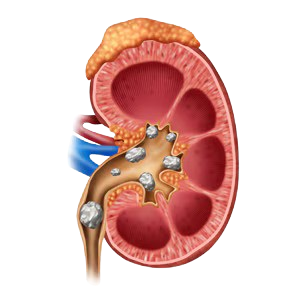- Call Anytime: +91 89841 97801
- mishrasumant20@gmail.com
Kidney Ston
Best Process for Kidney Stone Removal Treatment
Shockwave lithotripsy, uteroscopy, percutaneous nephrolithomy or nephrolithotripsy.
Kidney stone removal treatment focuses on eliminating stones that form in the kidneys due to the accumulation of minerals and salts. Kidney stones can cause severe pain, urinary problems, infections, and, in some cases, kidney damage if left untreated. The treatment method depends on the size, location, and type of the stone, as well as the patient’s symptoms and overall health.
Small stones, usually less than 5 mm, can often pass naturally with increased hydration and pain management, while medications like alpha-blockers may be prescribed to relax the ureter and facilitate stone passage.
For medium-sized stones between 5-20 mm, minimally invasive treatments are often required. Extracorporeal Shock Wave Lithotripsy (ESWL) uses high-energy sound waves to break stones into smaller fragments that pass naturally through urine. Another common procedure is ureteroscopy (URS), where a thin tube is inserted through the urethra to break and remove stones using a laser or forceps. In cases where stones are too large or difficult to access, Percutaneous Nephrolithotomy (PCNL) is performed through a small incision in the back to directly remove the stones from the kidney.
For large or complex stones exceeding 20 mm, surgical intervention may be necessary. Although rare, laparoscopic or open surgery is used when other treatments are ineffective, particularly for obstructive stones that severely impact kidney function. Following treatment, preventive care is crucial to avoid recurrence. Patients are advised to drink plenty of water, follow dietary modifications such as reducing salt and oxalate-rich foods, and undergo regular monitoring to detect any potential stone formation early. The benefits of kidney stone removal include immediate pain relief, restored urinary function, and improved quality of life, particularly with minimally invasive techniques that ensure faster recovery.
Small stones, usually less than 5 mm, can often pass naturally with increased hydration and pain management, while medications like alpha-blockers may be prescribed to relax the ureter and facilitate stone passage.
For medium-sized stones between 5-20 mm, minimally invasive treatments are often required. Extracorporeal Shock Wave Lithotripsy (ESWL) uses high-energy sound waves to break stones into smaller fragments that pass naturally through urine. Another common procedure is ureteroscopy (URS), where a thin tube is inserted through the urethra to break and remove stones using a laser or forceps. In cases where stones are too large or difficult to access, Percutaneous Nephrolithotomy (PCNL) is performed through a small incision in the back to directly remove the stones from the kidney.
For large or complex stones exceeding 20 mm, surgical intervention may be necessary. Although rare, laparoscopic or open surgery is used when other treatments are ineffective, particularly for obstructive stones that severely impact kidney function. Following treatment, preventive care is crucial to avoid recurrence. Patients are advised to drink plenty of water, follow dietary modifications such as reducing salt and oxalate-rich foods, and undergo regular monitoring to detect any potential stone formation early. The benefits of kidney stone removal include immediate pain relief, restored urinary function, and improved quality of life, particularly with minimally invasive techniques that ensure faster recovery.
Benefits of Kidney Stone Removal Treatment :-
Kidney stone removal treatment offers several significant benefits, improving both health and quality of life. One of the most immediate advantages is pain relief, as kidney stones can cause severe discomfort and urinary blockage. Removing the stones restores normal urine flow, preventing complications like infections and kidney damage. Additionally, modern minimally invasive procedures such as shock wave lithotripsy (ESWL), ureteroscopy (URS), and percutaneous nephrolithotomy (PCNL) allow for quicker recovery with minimal scarring and shorter hospital stays compared to traditional surgeries.
Another major benefit is the prevention of further complications. Untreated kidney stones can lead to urinary tract infections, kidney swelling (hydronephrosis), or even permanent kidney damage. Timely treatment eliminates these risks and ensures long-term kidney health. Furthermore, removing kidney stones enhances overall well-being and daily comfort, allowing patients to return to their normal activities without the constant fear of sudden pain or medical emergencies.
Post-treatment care, including proper hydration and dietary adjustments, significantly reduces the risk of stone recurrence. Patients who undergo kidney stone removal also benefit from personalized medical guidance, helping them adopt healthier lifestyles to prevent future stone formation. Overall, kidney stone removal treatment provides lasting relief, restores urinary function, and helps maintain optimal kidney health, ensuring a better quality of life.
Another major benefit is the prevention of further complications. Untreated kidney stones can lead to urinary tract infections, kidney swelling (hydronephrosis), or even permanent kidney damage. Timely treatment eliminates these risks and ensures long-term kidney health. Furthermore, removing kidney stones enhances overall well-being and daily comfort, allowing patients to return to their normal activities without the constant fear of sudden pain or medical emergencies.
Post-treatment care, including proper hydration and dietary adjustments, significantly reduces the risk of stone recurrence. Patients who undergo kidney stone removal also benefit from personalized medical guidance, helping them adopt healthier lifestyles to prevent future stone formation. Overall, kidney stone removal treatment provides lasting relief, restores urinary function, and helps maintain optimal kidney health, ensuring a better quality of life.

Dr. Sumanta Mishra on Benign Prostatic Hyperplasia
Send us a message


